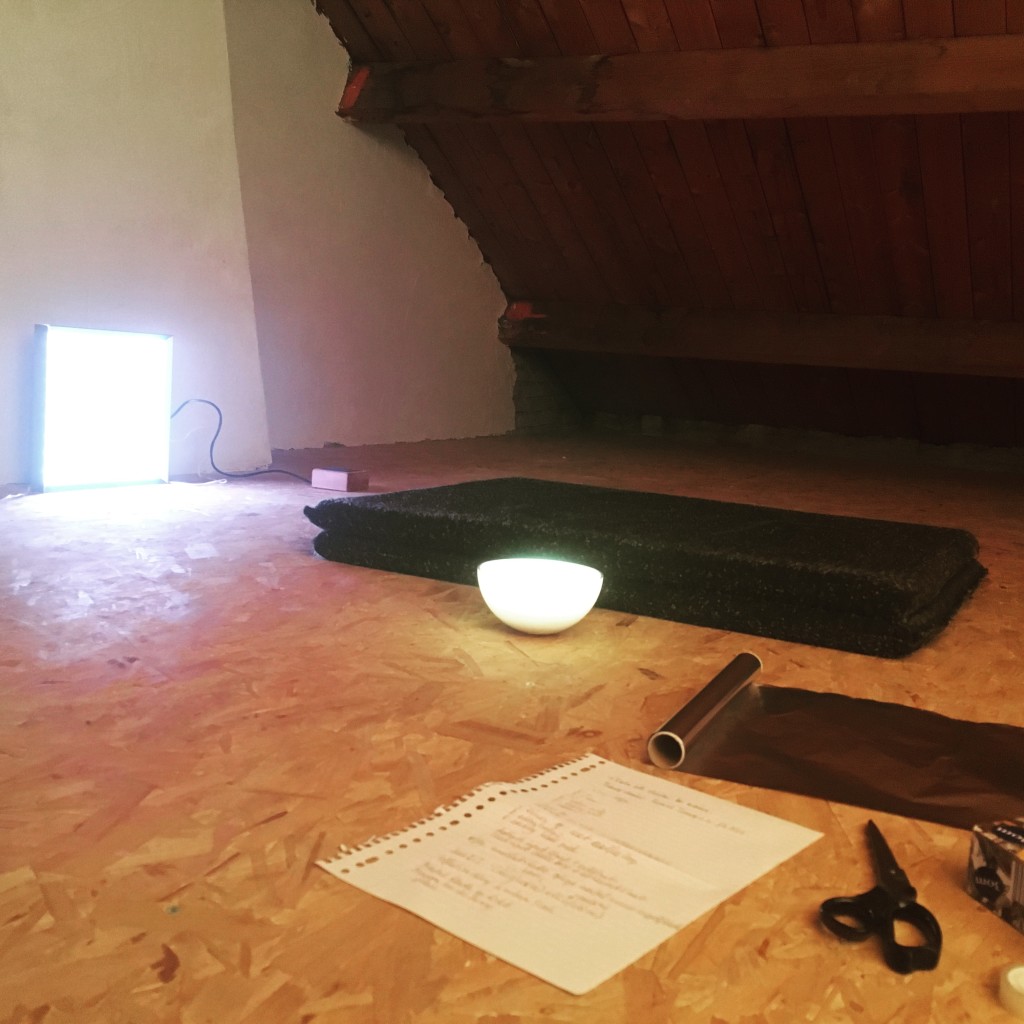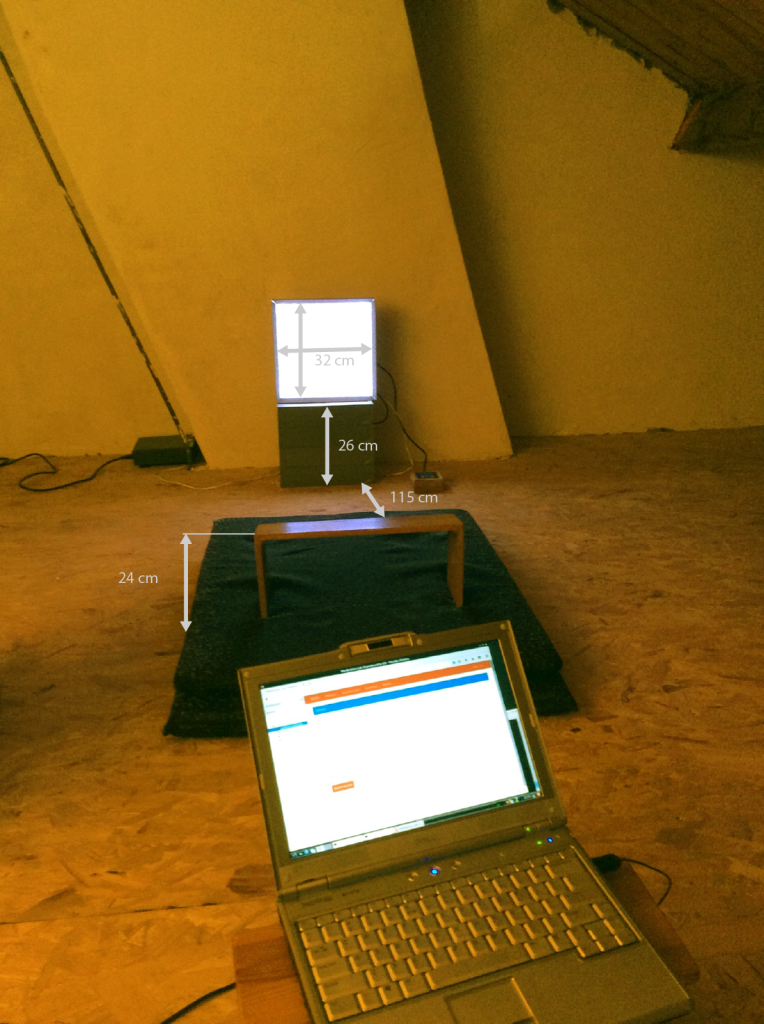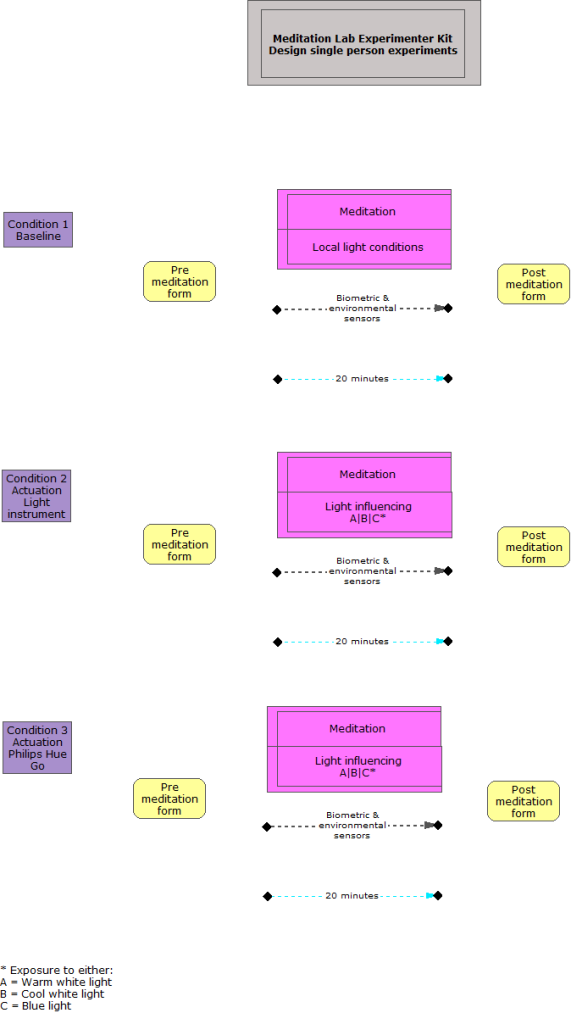A romantic dinner by candle light, bright lights in an office building. Both give us a very different experience. We all know from experience how light can influence our mood and the way we perceive a space.
What I want to find out with Meditation Lab is if light conditions can also influence the quality of your meditation experience. I have a hunch that it does. This is also based on over 20 years of daily meditation practice. And I’ve found starting points on optimal lighting during meditation in scientific research.

Conditions for a good meditation session
Contrary to a commonly held belief meditation isn’t about being relaxed and a little sleepy. I practice in the Buddhist tradition of Vipassana (insight) meditation. This form of meditation is about being fully present in the moment without effort. This clear observation will give a person insight into the true nature of reality. This insight will help to overcome suffering and to become a wiser and more compassionate being. An important concept in this context is the Satipatthana.
So the ideal state for a good meditation session is being relaxed but at the same time alert. I had heard about changing light conditions in classrooms to support different activities and states of mind of students. I was also wondering if work had been done on the psychological aspects of light. I’ll summarize my findings and tell about how I will be translating that into one person experiments.
Working with a light expert
Before diving into the theory I would like to explain how I will go about changing the light conditions. I was very fortunate be introduced to Tom Bergman. He is Principal Scientist at Philips Lighting. He has been working on what he calls Light instruments: LED light systems that can be programmed and played like a musical instrument. With his instruments he wants to go beyond mere functionality and use light for expression and experience. Our goals and explorations were a perfect match. I will be using his 9 x 9 mosaic instrument. It can make all colours and make beautiful and unexpected colour transitions. Also interesting is that it has been tested as tool for relaxation by master student Nina Oosterhaven (1). Her study showed for example that looking at changing patterns of light showed a significant reduction in heart-rate. So there are interesting starting points to work with the instrument.
The light instruments are of course very specialized and not commercially available. So Tom kindly also supplied me with a Philips Hue Go. This will enable me to try out similar settings with a consumer device which is already Internet of Things ready.

Types of light
Psychological effects
In the various articles I read I was looking for settings in light colour and intensity that would either relax or activate people and make them alert. There hasn’t been much research on the psychological effects of lighting. Seuntiens and Vogels(2) have done research on atmosphere and light characteristic in living room settings with a group of light designers. They looked at four types of atmospheres of which activating and relaxing are relevant for Meditation Lab. Interesting were their findings on the influence of colour temperature, brightness and dynamics on these atmospheres. In general the findings were: warmer (+/- 2700 Kelvin), static and less bright light (180 lux) is perceived as relaxing. Cooler (+/- 3800 K) and brighter light (390 lux) is perceived as activating this light can have a slow dynamic.
School performance
Sleegers et al (3) looked at school performance in children and students under adjusted light conditions. Their studies used build in light systems which had different settings. Focus, calm and engery are the most interesting for my project. Energy is an interesting setting, it is used in the morning or after mealtime to overcome sluggishness. The settings correspond with the following light properties (measured at eye-hight):
Energy:650 lux and 12000 K colour temperature
Focus:1000 lux and 6500 K colour temperature
Calm:300 lux and 2900K
Staying awake
Jacques Taillard et al (4) studied the effects of blue light on staying awake whilst driving a car at night. They compared the effects of continuous blue light to drinking coffee. When compared to a placebo both coffee and the blue light condition reported significantly less inappropriate line crossings with coffee doing only slightly better then blue light. The light source was a Philips GOLite with a wavelength of 468 nm. Luminance level was around 20 lux measured at eye level.
Research design
Sleepiness, tension and lack of focus are challenges you face when meditating. By experimenting with different types of light I want to find out if the findings in other areas can be used in a meditation setting. I will use warm white light for relaxation, cool white light for focus and blue light for alertness. I will be exposed to one light condition per 20 minute meditation session. Before and after every session I fill in the standardised questionnaires which I have designed. I have started single person experiments (n=1) and I have designed the following experiments.

There is no baseline measurement included in the single person meditation session. Instead I have conducted 54 baseline session under my usual meditation conditions. I did a 6 day solitary retreat at home. The sessions took place throughout the day, I didn’t manipulate anything, especially not the light conditions. So they varied widely as the day progressed.
Current findings
At the moment I’m conducting n=1 experiments using the Light instrument and the three main light states described above. I’ve set up a darkened lab to control the light conditions. I keep my eyes slightly open with my gaze turned down.
My first impressions are that there is a difference from what I normally experience during meditation. The white lights I find quite relaxing and somehow invigorating. The blue light I find less pleasant and a bit depressing. I suppose the light will interact with my overall state of focus, sleepiness and alertness as it fluctuates during the day. That is why I try to do the experiments at different times of the day while using the same light setting. I do worry a bit about my sleep when meditating in the evening in bright light. For that reason I have turned down the brightness (there a 5 settings) in an effort to not affect my sleep too much.
The single person experiments are my starting point. Later I will report on my design for group experiments. I’m always on the lookout for people who would like to join the experiments. So please leave a comment if you want to participate.
References
1) Oosterhaven, N. (2017). Fascinated by Dynamic Lighting. Thesis Master of Science In Human Technology Interaction
2) Seuntiens, P.J.H. & Vogels, Ingrid. (2008). Atmosphere creation: The relation between atmosphere and light characteristics. Proceedings from the 6th Conference on Design and Emotion 2008.PJC Sleegers, PhD, NM Moolenaar, PhD, M Galetzka, PhD, A Pruyn, PhD, BE 3) Sarroukh, PhD, B van der Zande, PhD (2013). Lighting affects students’ concentration positively: Findings from three Dutch studies. Lighting Research & Technology Vol 45, Issue 2, pp. 159 – 175
4) Taillard J, Capelli A, Sagaspe P, Anund A, Akerstedt T, Philip P (2012) In-Car Nocturnal Blue Light Exposure Improves Motorway Driving: A Randomized Controlled Trial. PLoS ONE 7(10): e46750.